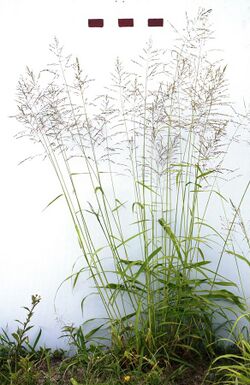Biology:Megathyrsus maximus
| Megathyrsus maximus | |
|---|---|

| |
| Scientific classification | |
| Kingdom: | Plantae |
| Clade: | Tracheophytes |
| Clade: | Angiosperms |
| Clade: | Monocots |
| Clade: | Commelinids |
| Order: | Poales |
| Family: | Poaceae |
| Subfamily: | Panicoideae |
| Genus: | Megathyrsus |
| Species: | M. maximus
|
| Binomial name | |
| Megathyrsus maximus (Jacq.) B.K.Simon & S.W.L.Jacobs, 2003
| |
| Synonyms | |
Megathyrsus maximus, known as Guinea grass and green panic grass,[1] is a large perennial bunch grass that is native to Africa and Yemen. It has been introduced in the tropics around the world. It has previously been called Urochloa maxima and Panicum maximum. It was moved to the genus Megathyrsus in 2003.[3]
Description
Megathyrsus maximus grows naturally in open grasslands, usually under or near trees and shrubs and along riverbanks. It can withstand wildfire and drought. The species has broad morphological and agronomic variability, ranging in height from 0.5 to 3.5 m (1.6 to 11.5 ft), with 5–10 cm (2.0–3.9 in) stems. The plant also can reproduce through apomixis, effectively cloning itself through seed. Panicles are open, with as many as 9,000 seeds per plant.
Uses
It can be used as a long-term foraging grass if grazed consistently and if fertilized. It is well suited for cut-and-carry, a practice in which grass is harvested and brought to a ruminant animal in an enclosed system. Shade tolerance makes it suited to coexisting with trees in agroforestry. Some varieties have been used successfully for making silage and hay. The leaves contain good levels of protein (6–25% depending on age and nitrogen supply).
Invasive species
In some places, such as South Texas , Sri Lanka[4] and Hawai'i,[5] it is an invasive weed that suppresses or displaces local native plants and is a fire hazard.[6]
In the Australian state of Queensland, the Queensland Acclimatisation Society introduced Guinea grass to 22 locations between 1865 and 1869.[7]
See also
- 2023 Hawaii wildfires
References
- ↑ 1.0 1.1 {{citation | mode = cs1 | title = Megathyrsus maximus | work = Germplasm Resources Information Network (GRIN) | url = https://npgsweb.ars-grin.gov/gringlobal/taxonomydetail.aspx?447623 | publisher = [[Organization:Agricultural Research ServAgricultural Research Service (ARS), United States Department of Agriculture (USDA) | access-date = 2010-01-07 }}
- ↑ Panicum maximum. Tropical Forages.
- ↑ Megathyrsus. Grass Manual. Flora of North America.
- ↑ Dhanesh Wisumperuma, “First known record of guinea grass cultivation in Sri Lanka, 1801-1802”, Journal of the Royal Asiatic Society of Sri Lanka 53, 2007: 219-22.
- ↑ Anguiano, Dani (August 10, 2023). "Hawaii wildfires: how did the deadly Maui fire start and what caused it? Rapidly moving fires that exploded on Tuesday night on the island of Maui have killed dozens and displaced thousands". The Guardian. https://www.theguardian.com/us-news/2023/aug/09/hawaii-wildfires-maui-explainer.
- ↑ Shingler, Benjamin (August 9, 2023). "Why Maui's deadly wildfires spread so quickly". CBC News. https://www.cbc.ca/news/climate/maui-fires-explainer-1.6932886.
- ↑ Clements, R. J. and E. F. Henzell. (2010).Pasture research and development in northern Australia: an ongoing scientific adventure. Tropical Grasslands 44, 221–30.
External links
Wikidata ☰ Q50846435 entry
 |

